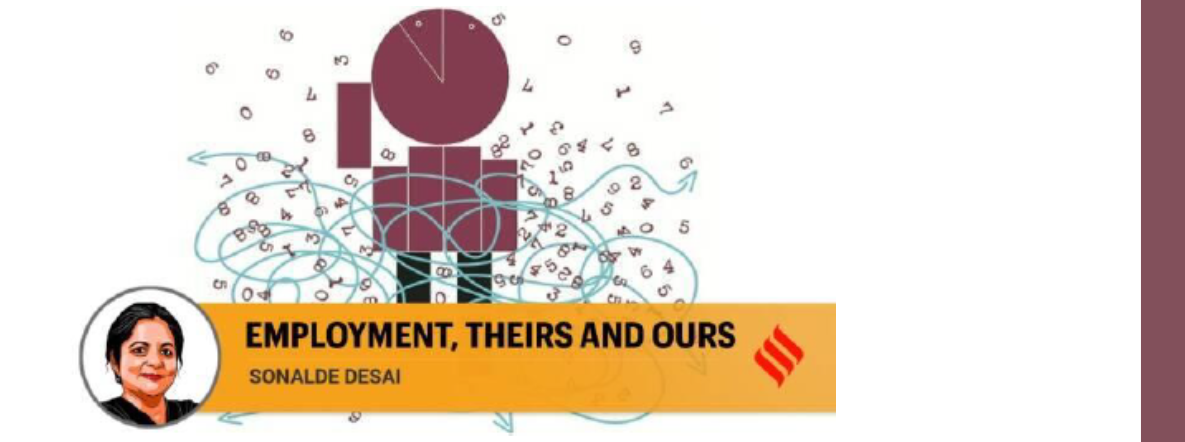India’s employment problem and bad statistics
26 May 2023
Opinion: Sonalde Desai.
The country is under pressure to alter its definition of unemployment to an international benchmark. Its once-vaunted statistical system is at a low ebb.
Our faith in India’s once-vaunted statistical system is at such a low ebb that it is hard to trust its judgment, even when it is based on a sound rationale. How to define and measure employment is one such example. The Indian definition of employment does not meet international standards. This has resulted in strong recommendations from international bodies to revise India’s definition of who is employed and who is not. The International Labour Organisation (ILO) has urged India to follow the standards laid down by the 19th International Conference of Labour Statisticians (ICLS-19), held in 2013.
The question is: Are these recommendations appropriate for a transitional economy, in which a large proportion of the population continues to engage in agriculture, often supplemented by casual wage work? To evaluate this, we first need to understand the recommendations made by ICLS-19 and then examine them within the Indian context. Two major recommendations of ICLS-19 are: (1) Employment data should rely on short-term measures of employment, in most cases, a 7-day measure, capturing employment during the preceding week; (2) it should measure all types of work, including unpaid work, but define a person as being employed only if he or she engaged in producing goods or services for pay or profit. This distinction between work and employment may have critical implications for the measurement of progress towards SDGs.
The global recession of 2008 profoundly affected high-income countries and cast its shadow on countries and sectors closely linked to the global economy. In this context, international labour statisticians urged countries to obtain employment statistics that would examine and monitor “conditions of work” and construct measurements “useful for labour-management negotiations”. This required good estimates of underemployment resulting in advocacy for a short measurement period to reduce recall bias and limiting focus on activities for pay or profit. Exclusion of production of goods or services for own use was possibly put in place due to a conviction that countries were inflating employment rates for excluded groups, particularly women, by counting distress work instead of providing paying jobs.
But does this really make sense for countries with a large informal sector and subsistence farming? An interesting paper by Isis Gaddis from the World Bank and her colleagues shows that the adoption of this definition would lead to a large reduction in the proportion of the population considered employed in rural Nigeria and Malawi. This would reduce the proportion of individuals defined as being employed by as much as 50 per cent in some conditions.
This could also be the case with India. My calculations based on the India Human Development Survey, conducted by the University of Maryland and the National Council of Applied Economic Research in 2011-12, show that nearly half the households that undertake cultivation do not sell their produce that year. Often this is because farms are small and barely produce enough for family consumption. However, many small and marginal farmers also work as wage labourers or salaried workers, and the impact of this restriction is relatively minor: Over 90 per cent of the individuals who worked at any time over one year in farming, as wage labour, in animal care, or business will be classified as employed according to the ICLS-19 definition of work for pay or profit if we take a year-long perspective. However, this masks substantial gender differences. As much as 95 per cent of men and only 85 per cent of women who are currently considered employed would be counted as being employed if the pay or profit limitation is placed. This would considerably reduce the already low estimates of women’s employment.
The recommendation to rely on a one-week reference period is even more likely to affect this classification. While a short reference period would reduce measurement error, it would be akin to looking for keys under a streetlight. A vast proportion of rural Indians engage in multiple activities combining farm work with work in construction, MGNREGS work, or other work in nearby towns. However, when it is time to sow or harvest, they devote all their time to farming. When surveys occur during this period, many individuals would be classified as farmers, and based on IHDS estimates, 45 per cent may be classified as producing only for home consumption. Thus, they would not be counted as employed even if they are engaged in income-producing activities during other parts of the year.
Changing definitions would underestimate the strength of the Indian economy and not serve any policy purpose. Despite this potential for an artificial decline in employment, the advocacy from international bodies for adopting ICLS-19 recommendations remains strong. Yet, surprisingly few cautionary voices are being heard outside the Ministry of Statistics and Programme Implementation (MOSPI), and even MOSPI has yet to articulate its viewpoint persuasively. This points to a bigger tragedy. India’s once-strong statistical system has suffered a severe reputational loss in recent years, brought about by MOSPI’s disavowal of its own poverty data and failure to invest in its analytical capacity. Unless the statistical system develops the self-confidence to assertively engage with international organisations, is willing to adopt global best practices where it makes sense and resists pressure to do so when it does not serve policy needs, it will continue to be held in low esteem nationally and internationally.
The writer is Distinguished University Professor, University of Maryland, and professor and centre director, NCAER National Data Innovation Centre. Views are personal
Published in: The India Express, 26 May 2023






